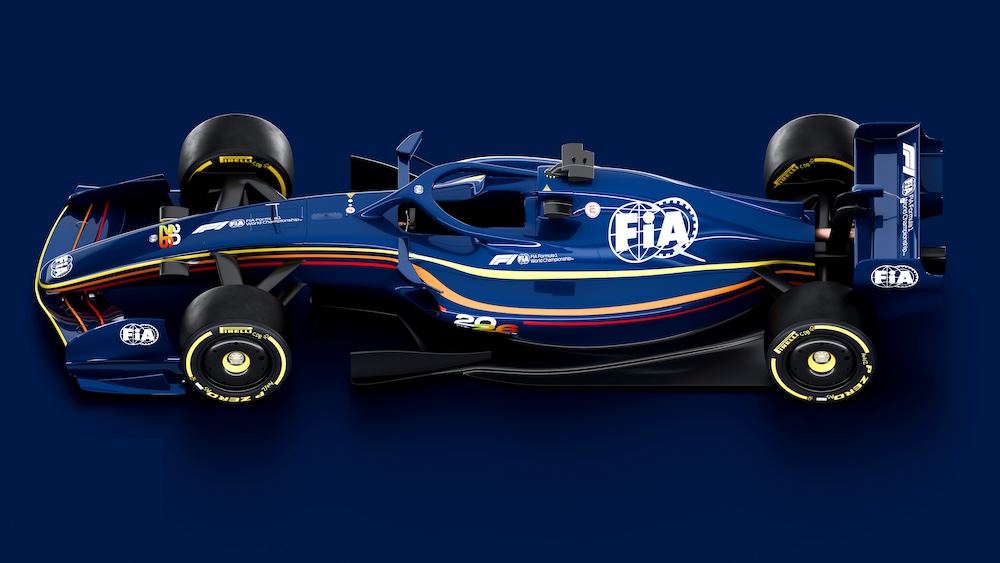The FIA has unveiled a major update in the 2026 Formula 1 technical regulations with a “nimble car” concept aimed at producing smaller, lighter machinery.
The power unit regulations for 2026 were confirmed two seasons ago and helped attract new manufacturers into the sport, but the actual technical regulations for the chassis and aerodynamics have remained a work in progress. That’s partly due to the FIA wanting to adapt them to the demands of the power units — featuring a nearly 50:50 split of internal combustion and electrical propulsion — and has led to a number of radical solutions.
The cars are intended to have a minimum weight some 30kg lighter than the current 798kg (1759 lbs), while a shorter wheelbase — down from 3600mm to 3400mm — and reduction in width by 100mm are also key components in what the FIA calls its “nimble car” concept. The width of the tires has also been reduced by 25mm at the front and 30mm at the rear.
Active aerodynamics will see both the front and rear wings changing from high downforce settings — known as Z-mode — for corners, to a low drag configuration — X-mode — for the straights. That’s to make more efficient use of the greater electrical energy from the power unit, with 350kw of power available from the battery and a reduction to around 400kw from the ICE that will be powered by a 100% sustainable fuel.
As the aerodynamics are set to be available to all drivers on every lap, in place of DRS the FIA is also introducing a “manual override” feature that will deliver maximum electrical energy deployment at higher speeds for a following car.
The FIA also says cars will feature a partially flat floor and lower-powered diffuser “which will reduce the ground effect and reduce the reliance of the cars on ultra-stiff and low setups.”
 The new technical regulations are set to be ratified by the World Motor Sport Council on June 28, although teams are not allowed to work on aerodynamic development — with those rules still to be refined — until Jan. 1, 2025.
The new technical regulations are set to be ratified by the World Motor Sport Council on June 28, although teams are not allowed to work on aerodynamic development — with those rules still to be refined — until Jan. 1, 2025.
“Today, the FIA is defining a hugely exciting future for the pinnacle of motorsport with the launch of a comprehensive new set of regulations for the 2026 FIA Formula 1 championship and beyond,” FIA president Mohammed Ben Sulayem said. “Following the publication of 2026 power unit regulations two years ago we have taken the opportunity to redefine the chassis regulations to match the energy requirement of the new power units. Collaborating with our partners at Formula 1 and with the assistance of the sport’s 10 teams and all our stakeholders this represents a unique revision that will ensure our premier championship is even more relevant to what is happening in the world.
“The power unit regulations have already resulted in a record number of PU manufacturers committing to the sport. And now, in tandem with chassis regulations that provide for lighter, more agile cars featuring innovative aerodynamic solutions, we have created a set of regulations designed to not only improve racing but also to make the championship even more attractive to PU manufacturers, OEMs and existing competitors.
“The key features of the 2026 F1 regulations are advanced sustainability technology and safety. Our aim, together with Formula 1, was to produce a car that was right for the future of the sport’s elite category. We believe we have achieved that goal.”
[lawrence-auto-related count=3 category=1388]
F1 CEO Stefano Domenicali agrees with Ben Sulayem that all key stakeholders have worked well together on the new regulations, that will again see all teams designing new cars under a cost cap.
“These regulations mark a significant moment in the future of our sport as we look forward to a new generation of car and power unit that aims to give our fans closer and exciting racing,” Domenicali said.
“The new sustainably fueled hybrid power unit presents a huge opportunity for the global automotive industry — the drop in fuel has the potential to be used by cars around the world and dramatically cut emissions. Its potential is one of the key reasons why we will have a record number of engine suppliers in Formula 1 in 2026.
“We enter this new regulatory cycle with the sport in the strongest position it has ever been, and I am confident that the work done by the FIA to create these regulations will further strengthen the position of the sport around the world.”
